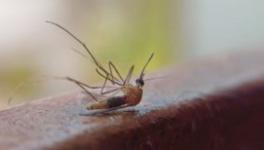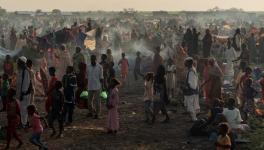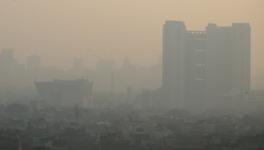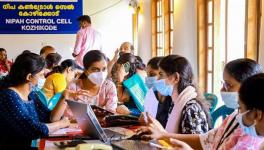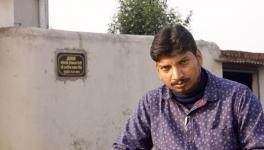Malnutrition, Malaria hit Tribals in Maoist Hotbed
Lakheswari in Kadampara village of Bastar district in Chhattisgarh
Lakheswari can only crawl as her legs are too weak to bear the weight of her fragile 5.5 kg body. The stunted and bony 2.5-year-old girl is an example of the malnourishment caused by the pandemic-induced break in the supply of ready-to-eat food packets provided by the state government to poor children. Her father Asha Ram earns a meagre Rs 250 a day depending on the availability of work at a construction site in Jagdalpur, the district headquarters of Bastar, Chhattisgarh, 27 km from his village Kadampara.
In 2020, Anganwadi workers informed Ram about his daughter’s stuntedness. He recalls the loss of livelihood and eating only one meal a day during the lockdown. The leftover rice of the previous day was the meal for the next day. The impoverished family, which could barely sustain itself, was unable to provide the required diet to its daughter, making her prone to morbidity and mortality.
The Tonguda Hospital, in Kadampara, has been locked for the last ten years.
Kadampara, which has several villagers with severe-to-moderate malnourishment, has a defunct hospital locked for the last ten years. Had Tonguda Hospital been functional, patients with malaria, dysentery and diarrhoea could have been treated there. The hospital could have also treated acute cases of malnourishment and starvation, says Hemlata Sethia, an Anganwadi worker deputed at the Kawalikal Panchayat Anganwadi Centre, beside the hospital. With the absence of a Nutritional Rehabilitation Centre, the villagers continued to suffer.
A Bastar district administration official claimed that 1.41 lakh malnourished children in the state were rescued between January 2019 and May 2021. Malnourished children in every village are provided jaggery, milk and eggs with the help of Mitanin (health volunteers in Chhattisgarh) and Anganwadi workers, the official told Newsclick.
Last year, on the occasion of the 151st birth anniversary of Mahatma Gandhi, the state government launched the Mukhyamantri Suposhan Yojana, aimed at making the state malnutrition-free, amid much publicity.
Sethia told Newsclick that the pandemic caused irreparable damage to the health of tribal children in Kadampara after the supply of milk and eggs provided thrice a week by the administration to, least, 47 children, including malnourished ones, was discontinued. Out of the 47 children, more than 10 had stunted growth. Even the ready-to-eat food packs are neither sufficient in quantity nor good in quality, another Anganwadi worker said.
“Tribals in resource-rich regions, like Bastar, of the state have been the worst victims of fatal diseases like malaria. In the absence of health care in tribal hamlets, the undernourished population is rising. Besides, increasing inflation has added to their problems,” says social activist Shakeel Rizvi. The unofficial count of undernourished toddlers in approximately 10 villages is 150 with girls outnumbering boys in both severe acute malnutrition and moderate acute malnutrition, he told Newsclick.
Subhadra in Randhariras village, Bastar.
With a protruding belly and a possible enlarged liver, four-year-old Subhadra, of village Randhariras, is a case of moderate malnutrition. The stunted child weighs 9 kg, which is 2 kg less than the World Health Organization’s weight-age chart.
Subhadra’s father Dashru Nag is a landless daily wage labourer employed at a wood factory. When asked whether she receives a proper diet, including protein, he sarcastically points to his bow and arrow indicating that could be only possible if he hunts a rabbit or fox. Not receiving Anganwadi facilities has impeded her recovery and made her prone to slip again into severe malnutrition.
Ankita in Pushpal village, Bastar.
Ankita is among the worst cases of malnutrition with her father Jaideo blind and mother Chaiti physically disabled. Fifteen km away from Jagdalpur town in Pushpal village, the five-year-old barely manages to walk due to her bowed legs. The family of three is deprived of every government scheme. Jaideo and Chiati say they don’t receive any government support despite their disabilities. Jaideo earns livelihood by singing local folksongs using his soundbox in Jagdalpur. He ends the day by fetching barely Rs 100-Rs 150. The couple still awaits a tricycle and the required diet for Ankita.
Besides malnutrition, malaria is another problem for the tribals in the Maoist hotbed. The dense forests, especially during the monsoon, are an apt place for breeding the malarial parasites, resulting in multiple outbreaks.
When the population staying outside the forests of Bastar was struggling to survive during the pandemic, the tribal hamlet of Randhariras was battling a second malaria outbreak. At least, one person in every household had malarial symptoms and diarrhoea, says Kallu Nag, a sexagenarian who was reinfected.
Dewali Nag, a health volunteer, in Randhariras village, Bastar.
Dewali Nag, a Mitanin, covers 39 households of Randhariras village to provide medical help with the support of Jagdalpur health centre workers, who supply her medicines.
The reason for the consecutive malaria outbreaks in the village is apparently the missing tablets of Primaquine’, the only anti-malarial drug currently recommended. Nag’s daughter found in December that the tablets were not part of the medicines handed over to her by health workers.
Shankar Barse, a farmer, in Chittalgur Bade Para.
Chittalgur Bade Para is a hinterland having around 150 people within the Kanger Valley National Park, in Bastar. A malaria outbreak ravaged it three months ago with hundreds of symptomatic cases and the death of two girls.
Shankar Barse, 38, a marginal farmer who was infected with malaria in May, told Newsclick, “We are accustomed to getting infected to the disease at regular intervals with no access to health services. There were no rapid tests (finger pricking), door-to-door screening or distribution of educative pamphlets. Patients had to cover 45 km to Nangur Community Health Centre (CHC) which often turns them away due to unavailability of medicines, to get a bottle of saline.”
Unlike other parts of Bastar, the government’s anti-malaria programme Malaria Mukt Bastar Abhiyan didn’t cover Chittalgur. The nearest Nangur CHC doesn’t have enough malaria testing kits and medicines, an employee told Newsclick on the condition of anonymity.
The Bastar zone, bigger than Kerala area-wise, is among the few regions endemic to the malaria parasites Plasmodium vivax and Plasmodium falciparum. According to official figures, 76% of malaria cases in the state are reported in the Bastar division, comprising seven districts (Bastar, Sukma, Dantewada, Bijapur, Narayanpur, Kanker and Kondgaon). In 2019, the Annual Parasites Incidence (API-Malaria) of more 13.12 in the Bastar division was the highest in the country.
Get the latest reports & analysis with people's perspective on Protests, movements & deep analytical videos, discussions of the current affairs in your Telegram app. Subscribe to NewsClick's Telegram channel & get Real-Time updates on stories, as they get published on our website.










